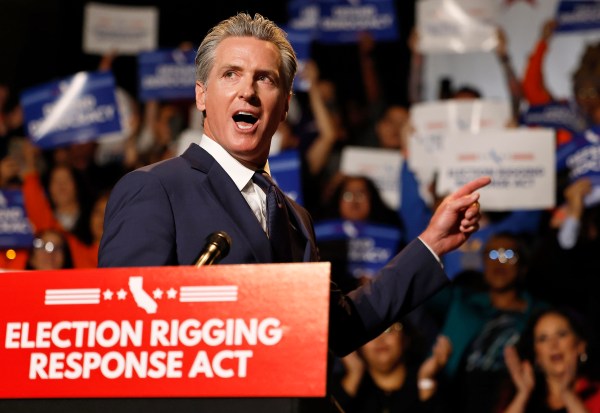While much attention has been (justifiably) focused on the brutal attacks in Israel, the Congressional Budget Office (CBO) quietly released some alarming numbers. The budget deficit for the 2023 fiscal year—which concluded September 30—topped a staggering $2 trillion. This not only doubled the 2022 budget deficit, it also became the largest single-year deficit increase in American history, outside of the temporary emergencies of both World Wars, the Great Recession, and the 2020 pandemic.
In fact—outside of those aforementioned emergencies—this year’s budget deficit is the largest in American history, equaling 7.7 percent of GDP. Those earlier emergency-driven deficits could each be justified as an unavoidable yet temporary one-time cost that a growing economy could absorb gradually. By contrast, today’s structural deficits are substantially more perilous because they are projected to continue growing larger essentially forever. Simply put, never before has Washington run such large deficits during relative peace and prosperity.
(Necessary caveat: While a deficit of $1.69 trillion has been commonly reported, President Joe Biden’s declared-and-then-blocked student loan bailout induced a federal accounting glitch that essentially classified more than $300 billion in 2023 spending within the 2022 budget totals. Yet the actual federal debt held by the public rose by $2 trillion in 2023, and this article’s figures remove that accounting glitch).
The culprits should be well known by now. CBO reports that Social Security costs rose by 11 percent last year, and Medicare spending (adjusted for timing shifts) leaped by 18 percent. And that is just the beginning, as the retirement of 74 million baby boomers will drive annual Social Security and Medicare shortfalls from $600 billion to $2 trillion within a decade. Decades of tax cuts have capped tax revenues, and an inflation-based revenue surge in 2022 gave way to a $455 billion revenue decline in 2023.
Within the past few years, Washington handed out tens of thousands of dollars to families that suffered no pandemic losses, bailed out private union pension systems, and lavished governors with hundreds of billions of dollars to close non-existent state budget gaps. President Donald Trump’s legislation and executive orders added $7.8 trillion to 10-year deficits, and it took just 20 months for President Biden to enact policies adding his own $4.4 trillion to 10-year deficits (not counting his attempted bailout of student loans). Even as Social Security and Medicare costs escalated, Washington sharply expanded discretionary spending and enacted major spending expansions for veterans, infrastructure, and the semiconductor industry. Not yet satisfied, Biden is still trying to sneak more student loan bailouts past the Supreme Court.
As Congress drove up budget deficits, this escalating national debt collided with interest rates that have soared to triple their pre-pandemic levels. Thus, in merely two years, the annual cost of interest on the federal debt doubled, from $350 billion to approximately $700 billion. And the CBO projects annual interest costs to double again to $1.4 trillion over the decade. That’s actually a rosy prediction, in that it assumes that Congress stops adding to deficits and that interest rates fall back. However, the Committee for a Responsible Federal Budget notes that most of the current federal debt is currently paying interest rates below 3 percent (and often below 2 percent), yet will soon be rolling over into rates between 4 and 6 percent. If interest rates stay elevated and Congress keeps extending tax cuts and adding spending, interest costs could top $2 trillion a year within a decade—consuming up to 30 percent of all federal tax revenues.
These rising interest rates are a ticking time bomb. Back in 2021, I released a study showing that Washington’s long-term fiscal projections are based on the questionable premise that interest rates stay below 4 percent essentially forever. Every additional percentage point that is sustained would cost $30 trillion over 30 years. Even the CBO’s baseline projections that assume interest rates never again exceed 4 percent show a federal debt—which was 35 percent of GDP as recently as 2007—soaring from 100 percent of GDP today to 180 percent within three decades. Assuming an extension of the Trump-era tax cuts, other traditional spending expansions, and interest rates of 5 to 6 percent, we could see the debt push toward 300 percent of GDP within three decades. In that scenario, interest costs alone would consume close to 100 percent of all tax revenues.
Are such interest rates plausible? Even if today’s inflation proves temporary, we are entering a period of long-term upward pressure on interest rates. The Federal Reserve is unlikely to return the federal funds rate to the anomalously low levels that prevailed from 2008 to 2021—an easy-money policy that eventually contributed to an 8 percent inflation rate. The global savings glut is receding, and retiring baby boomers will shift from building savings to drawing down savings. Consensus macroeconomic modeling suggests that the long-term increase in the federal debt will also produce 2 to 3 percentage points of upward pressure on interest rates.
That makes it hard to imagine how Washington will borrow $119 trillion (and more likely $150 trillion, assuming tax cut extensions and spending hikes) over 30 years to cover its projected deficits. China and Japan each hold roughly $1 trillion in U.S. debt and have neither the capacity nor interest to cover more than a tiny fraction of further American borrowing. Other countries limit their Treasury holdings, and the Federal Reserve has been trying to shrink its own $5 trillion holdings of Treasury debt. That leaves the U.S. financial markets—insurance companies, investors, pension funds, and state and local governments—to cover far more than $100 trillion in projected Washington borrowing. The impending debt surge has barely begun, and yet a Wall Street Journal headline already declared that, “Wall Street Isn’t Sure It Can Handle All of Washington’s Bonds.”
Initially, Washington’s insatiable borrowing demands will push up interest rates (which will in turn further widen budget deficits). But at a certain point, the financial markets may simply be unable to supply Congress’ lending demands at plausible interest rates. If and when these laws of economics and arithmetic bite back—and the bond market essentially cuts Washington off—the only remaining options will be to lean on the Federal Reserve to inflate away the debt or to impose a drastic and painful series of sharp tax increases and spending cuts.
Lest these fiscal warnings appear excessively alarmist, the sober-minded economists at the University of Pennsylvania’s Penn-Wharton Budget Model recently attempted to analyze America’s long-term fiscal outlook. Their study explains that leading economic models used by economists and by Congress “effectively crash when trying to project future macroeconomic variables under current fiscal policy. The reason is that current fiscal policy is not sustainable.” (Emphasis added.) In fact, the Penn-Wharton economists note that the current fiscal trajectory is so dangerously untenable that economic modelers are forced to add in an assumption that Washington aggressively raises taxes and/or slashes spending. They simply cannot model a functioning long-term economy at the baseline-projected debt levels.
Yet casually assuming that Washington will aggressively pare back these rapidly expanding budget deficits—an assumption that also explains the financial markets’ previously casual attitude toward unsustainable federal debt projections—seems quite naïve to anyone remotely familiar with the White House, Congress, and public opinion. Both private economists and federal budget offices have warned for decades that the retiring baby boomers would bring growing Social Security and Medicare shortfalls by the 2010s that would rapidly accelerate by the 2030s. Yet even back in the 1990s and 2000s—when a long-term fix would have been relatively pain-free—any reform proposal brought furious voter backlash. Voters convinced themselves that Social Security and Medicare are fully paid-for and cannot contribute to deficits. They believed that remaining budget deficits could be painlessly solved by absurd levels of economic growth, taxing the rich, or cutting waste, welfare, immigrant benefits, and foreign aid (or—the myth that will not die—simply removing the wage limit on Social Security taxes). Even the Tea Party movement of the early 2010s focused almost exclusively on that era’s Wall Street bailouts and stimulus spending, while mostly opposing the Social Security and Medicare reforms necessary to avert the coming debt deluge. Repeated warnings of an inevitable day of reckoning were dismissed. Almost no one believed it.
And most people are still in denial. Earlier this year, when the Social Security and Medicare trustees declared their trust funds to be just a decade from insolvency, President Biden and congressional Republicans competed to see which side could most vociferously rule out Social Security and Medicare reforms. Biden’s budget proposed another $2 trillion in spending hikes, and simply chose not to include the cost of trillions of dollars in endorsed tax cut extensions. Republicans offer empty rhetoric about runaway deficits while taking off the table any cuts to two-thirds of all spending (Social Security, Medicare, defense, veterans, and most infrastructure), and proposing new rounds of tax cuts. Donald Trump continues to emphasize that Social Security and Medicare will not be touched in a second presidential term. Even the more fiscally conservative GOP candidates promise no Social Security changes until the 2050s, and produce budget plans that add trillions in deficits.
Politicians are pandering to the large majority of voters who have responded to trillion-dollar deficits by demanding that Congress expand Social Security and Medicare—as well as hike spending on education, broader health care, infrastructure, poverty relief, border security, and child care. And yet polls also show that a strong majority of voters refuse to accept paying even one dollar in new taxes to close the deficit or finance their exorbitant spending demands. To put it gently, these demands are untethered from reality.
Therefore, it was no surprise that last month’s initial reports of a staggering $2 trillion budget deficit elicited a collective shrug from the White House, Congress, and voters. Only the financial markets responded by pushing interest rates to their highest levels since 2007. Ultimately, though, these financial markets will have the final say. Washington cannot borrow what investors will not lend, and a vicious cycle of rising debt and interest rates increasingly appears to be the most likely outcome. It is impossible to predict whether the financial markets will tap out in five, 10, or 20 years. But when they do, all the polls, political consultants, and pandering politicians demanding the continued free lunch of generous government programs and low taxes will not matter to the undefeated laws of economics and arithmetic.
The window for smart and gradual deficit reforms is beginning to close. Yet if the largest (non-emergency) budget deficit in American history doesn’t get the attention of lawmakers and voters, it is difficult to imagine what possibly will.






Please note that we at The Dispatch hold ourselves, our work, and our commenters to a higher standard than other places on the internet. We welcome comments that foster genuine debate or discussion—including comments critical of us or our work—but responses that include ad hominem attacks on fellow Dispatch members or are intended to stoke fear and anger may be moderated.
With your membership, you only have the ability to comment on The Morning Dispatch articles. Consider upgrading to join the conversation everywhere.